|
|
|
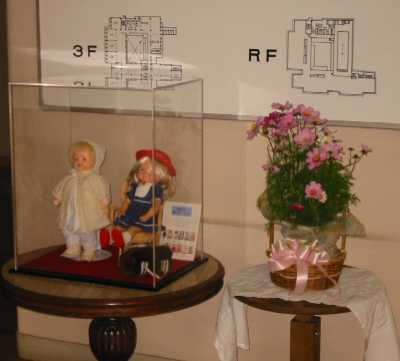
|

|
Two Friendship Dolls at
Entrance of School
|
|
|
Honcho Elementary School, located near the busy subway station of
Sakuragi-cho next to the Port of Yokohama, has a long history related to the
Friendship Dolls. Kazuo Deguchi, a sixth-grade teacher at Honcho who
transferred to another school in Yokohama in April of last year, created the
Blue-eyed Dolls Home Page several years ago. He worked together with his
students to gather information and photos from schools all over Japan that
have Blue-eyed Dolls sent by American children in 1927. The Blue-eyed Dolls
Home Page includes this information in addition to small photos and links to
web pages published by schools with Blue-eyed Dolls. Mr. Deguchi's web site
in Japanese gave me the idea in late 2000 to create something similar in
English about the stories behind the individual Blue-eyed Dolls located at
schools throughout Japan.
|
|
|
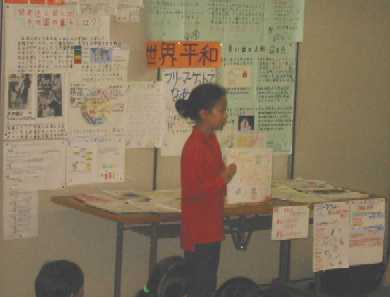
|
|
Sixth-grade Student Presents
Results of Research on Free Market
|

|
|
|
I know about Honcho Elementary School for a couple of other reasons. Two
years ago my wife Noriko coordinated an exchange of videos and other items
between the second grade at Honcho Elementary School and the second-grade
class at Braeburn Elementary School in West Hartford, Connecticut, where she
was working at the time as a teacher's assistant. This spring I received an
e-mail from Denice Minakuchi, who works as a teacher in Yokohama's
International Understanding Education (IUE) program and visits each class at
Honcho Elementary about four or five times a year. Her lessons are based on
non-political and non-religious topics about the U.S., her home country. Her
past lessons have covered a wide variety of topics, including the following:
|
|
|
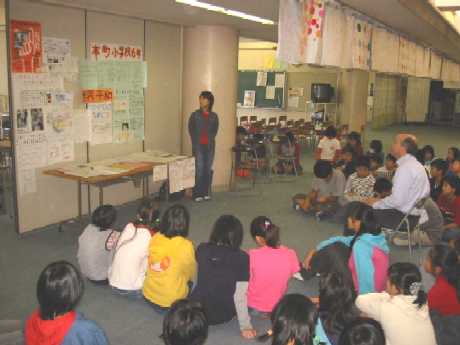
|

|
Sixth-grade Girl Presents
Topic on World Peace
|
|
|
- comparison of schools in U.S. and Japan
- farm animal sounds (with lower grades)
- variety of peoples and cultures in U.S. (with upper grades)
- games like 4-square and tetherball
- culture of Hawaii (where she went to college)
- comparison of animals in U.S. and Japan
- Halloween, Christmas, and other American holidays
She writes that the challenging and exciting part of these lessons is that
each class is conducted using only English with no translation. Ms. Minakuchi's
first e-mail to me this spring was a real coincidence since she had not heard
of Mr. Deguchi being a former sixth-grade teacher at Honcho nor of my wife's
coordinating the exchange between Honcho and the school in Connecticut.
|
|
|
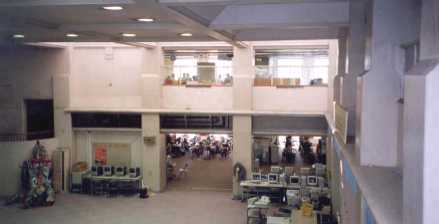
|
|
|
Open Space at Honcho Elementary
|

|
|
|
Upon entering Honcho Elementary School's building, I observed how
different the building's design is in comparison to all of the other
schools I have visited in Japan. The school uses the concept of open
classrooms, the first school in Yokohama to employ this design when Honcho
built a new school building about 20 years ago. In addition to the lack of
permanent walls between the classrooms, there was a large open space about
three stories high in the center of the building with the library on one side
and with many PCs on the other side. Although the building is quite different
than other Japanese schools that have Blue-eyed Dolls from America, like many
of the other schools Honcho Elementary proudly displays their two dolls in a
case at the entrance of the school. The original Blue-eyed Doll named
Blossom, which the school received in 1927, is displayed now at the nearby
Yokohama Doll Museum, but the doll at the school entrance is a replica that
looks just like the original. Next to Blossom is displayed a New Blue-eyed
Doll named Amanda given by Sidney Gulick, 3d, the grandson of the originator
of the project to send over 12,000 American dolls to Japanese children in
1927.
|
|
|
|
|
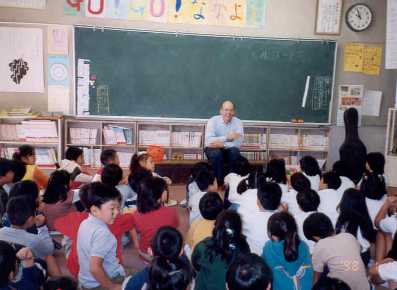
|

|
Chatting with Second Graders
|
|
|
I met first with 75 energetic second graders, who had many questions about
the foods and sports in the U.S. Since the school has so many PCs, I gave the
second graders a Frankenstein mouse pad to remember Halloween, which I talked
about with them during our time together. Next the sixth-grade students gave
presentations on the results of their studies on world peace. Representatives
from different teams covered their research on developing nations, the United
Nations, Friendship Dolls, free markets, and volunteer activities. The
presentations were supplemented by information and photos the students had
assembled on a large poster board displayed in front. In the last part of the
session, I gave a presentation about multicultural America and answered
questions about the Friendship Dolls and other topics covered by the students
in their presentations. After this interesting class on world peace, I
enjoyed eating a quick lunch with the sixth graders before leaving the
school.
|
|
|




